The Rainbow boa as the name implies is one of the most impressive species of snake on the earth.
But its characteristic name is from a highly iridescent glow which seems to give every color of the rainbow.
The rainbow boa can grow up to 5-6 feet. With optimum care and nourishment can also grow up to six and a half feet.
Concerning their care needs, they have relatively easy-care requirements as they don’t require specific temperature and lighting, nutrition is required only once a week. However, their nature can either be reclusive or aggressive, so they are not the best pet for beginners.
However, if you are about to take care of a shy yet beautiful snake, welcome here to a complete care guide for your pet.
Appearance
The Brazilian rainbow boa is also known as BRB- are also well known for their beautiful colors.
Its colors range from deep red to orange with a variety of striped patterns and spots all over the body. Their patterns consist of solid black stripes or spots with red and orange pigmentation in between.
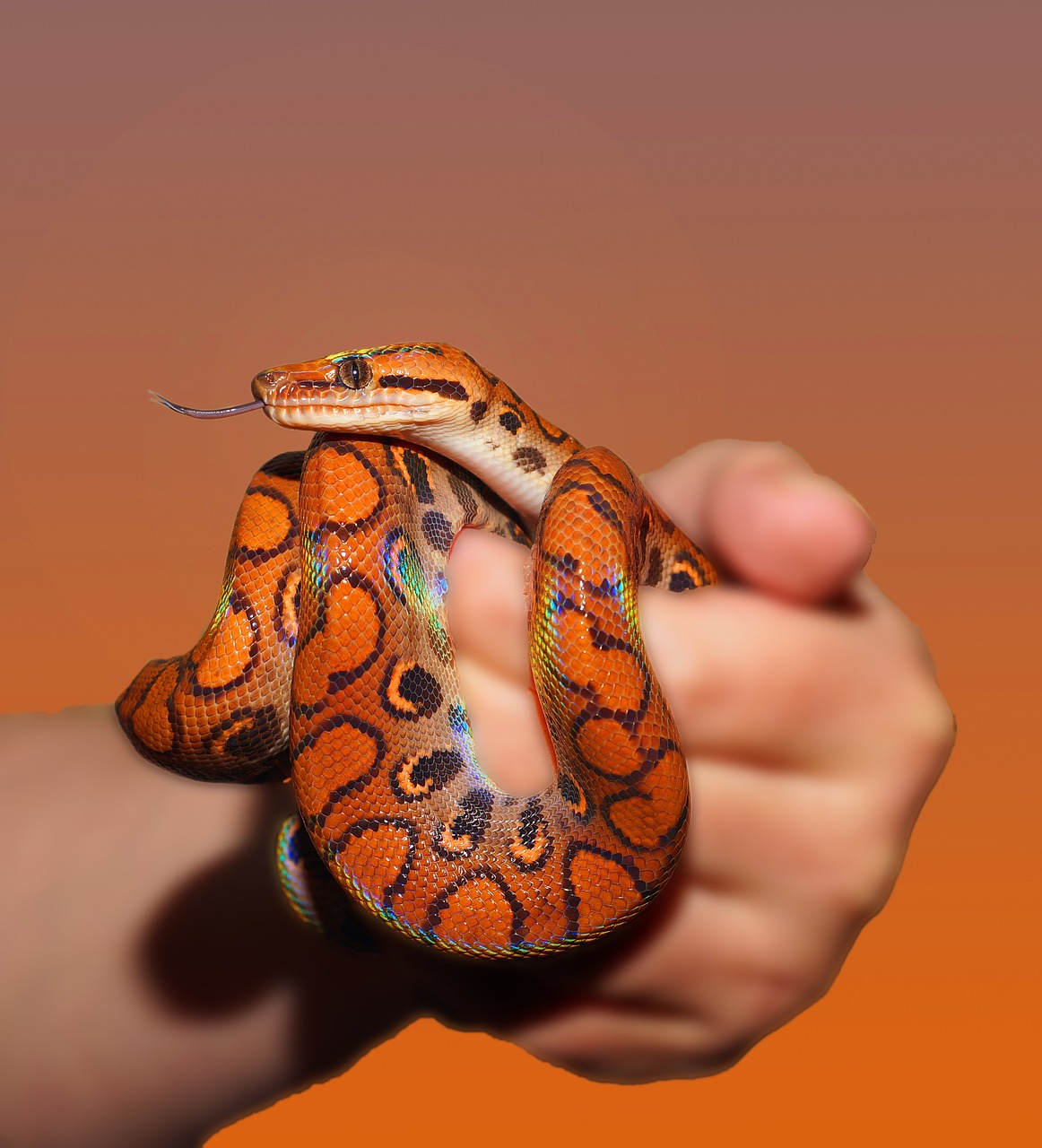
But its name is driven by the phenomenon of light reflection into all colors of the rainbow. The main reason for these scales, which are highly gleaming after shedding. The rainbow boa shed within ten days of birth followed by thrice a year.
Size
- Newly hatched boas are about 12-20 inches long.
- In one year, they grow up to 35-40 inches.
- The average adult size is 5-6 feet.
However, with optimum care and nourishment, they can grow up to 6.5 feet.
Lifespan
In natural environments, boas can live up to about 10 years. But in the enclosure, they live up to 20 years because there is no risk of predation to them.
Difference Between Males and Females
There is no obvious difference between both genders except for the length.
Female tends to grow more in length than male.
However, sexing of snakes can be done either by palpating the young ones for hemipenile sac by feeling/visibly seeing or by probing done by an experienced reptile keeper.
Another way to tell differentiate between sexes is that males have larger spurs at the entrance to the vent.
However, none of them is accurate.
Common Names
Despite its specific name it is distributed throughout the south and central America. Multiple species are mentioned as follows which come under the family genus “Epicrates.”
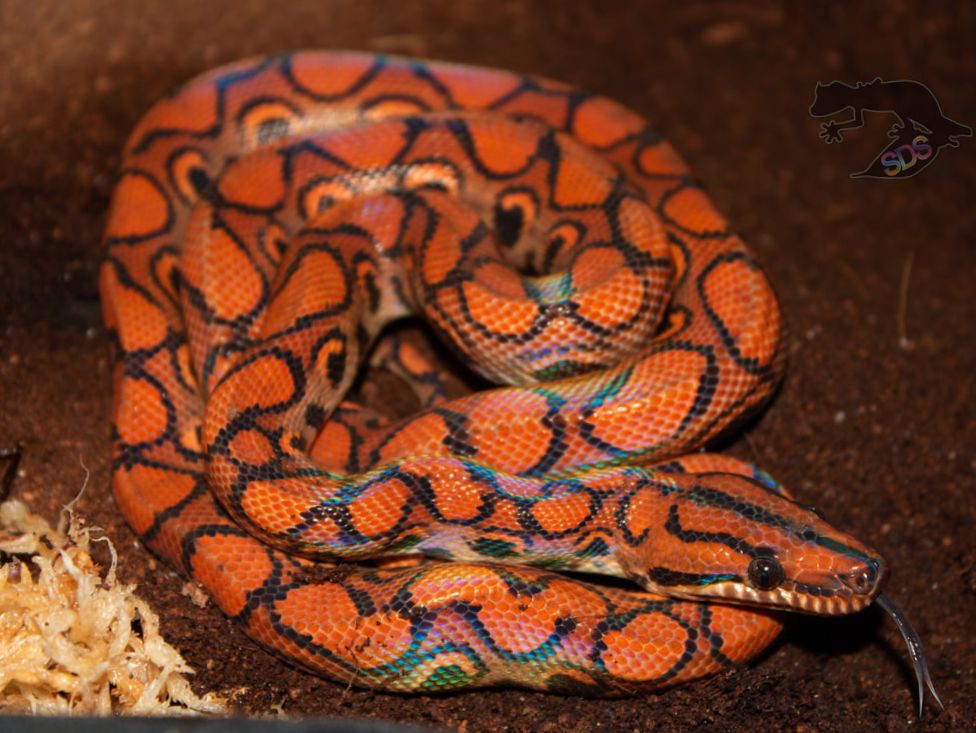
E. c. maurus
· E. c. assisi
· E. c. cenchria
· E. c. crassus
· E. c. gaigei
Habitat
Naturally, rainbow boas are inhabitants of rocky areas, forests, and cultivated areas. As the climate of souths and central America is hot as well as humid, replication of natural environments is necessary for housing.
In accordance with their shy nature, the rainbow boas are usually found in solitude, either slithering on the ground or hanging from low branches. They rarely interact with other snakes except in the breeding season when they compete for a female.
Typically, not being “Nocturnal” can be found active during the day as well as night, however, most likely to be active during evening and night-time.
Summary Table
| Scientific Name: | Epicrates Cenchria |
|---|---|
| Common name: | Brazilian rainbow boa, slender boa |
| Lifespan: | 20 years |
| Diet: | Large-sized mice and rats (dead or thawed), birds, fowl |
| Adult size/weight: | 5-6 feet and up to 4,00 grams |
| Tank size: | 6X2X2 feet glass vivarium\terrarium |
| Temperature: | 72℉ to 86℉ |
| Popular alternatives: | Rosy boa, sand boa, ball python |
Tank
“For an adult Rainbow boa, a 6X2X2 feet long terrarium works best, however, tank size should be according to age and size of your pet.”
Newly hatched boas can be placed in 32 quartz plastic storage containers and should be moved into larger enclosures per their growth.
About their shy nature, they should be kept alone in the enclosure, provided with a hide box as they spend most of their time hiding in the box.
Some owners consider providing their pets with some tree logs as they enjoy hanging or slithering on them, they’re also famous for enjoying housing in a shoebox.

The rainbow boas require fresh water for daily drinking, which should be provided in a large-sized as well as a heavy bowl that can support your pet’s weight and prevent it from tipping over.
Being inquisitive they like to explore their surroundings; it puts a good effect on your pet if you change the set-up of the terrarium once in a while. You will notice your pet re-exploring once put in a newly arranged set-up.
Lighting
As their color is a product of reflection of light, they should be best provided with a 40-watt spotlight for the warmer side of the enclosure. But rainbow boas do not tend to bask themselves so light should not be left on for longer periods.
Temperature
Naturally, they are inhabitants of hot environments, so the temperature of your pet’s enclosure should be high enough.
For the warmer side of the terrarium, heating pads will work well, however, the temperature should not be greater than 86°F and not lesser than 72°F on the cooler side of the tank. For monitoring, temperature levels keep thermometers on both sides.
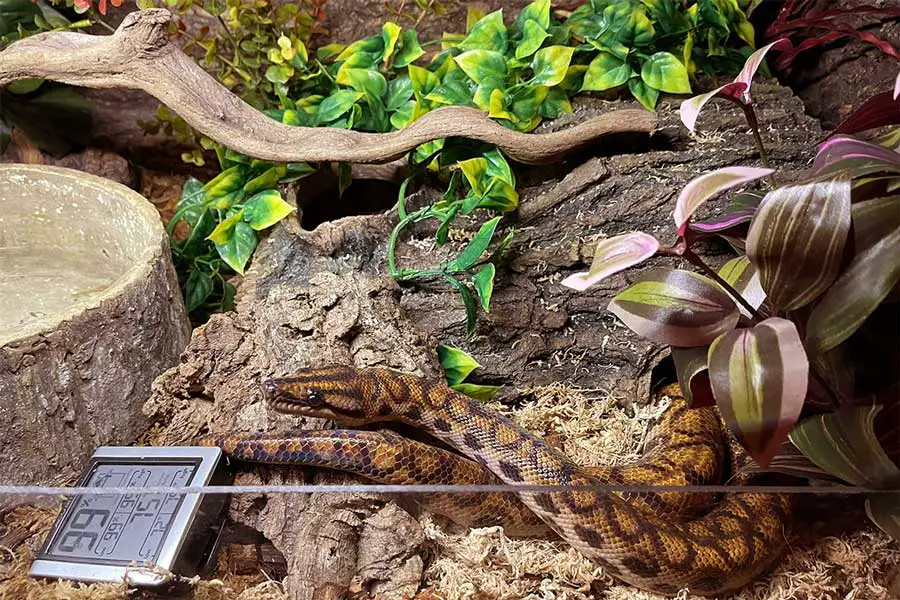
Humidity
Rainbow boas require a humid environment, so the terrarium must be misted daily to maintain humidity. As inside the house humidity levels will be too low for your pet.
As mentioned earlier water bowls should be provided in an enclosure, it is also beneficial to maintain humidity levels high.
For monitoring the humidity of the enclosure use a hydrometer. If humidity is consistently less than 70% (too low) consider adding a humid hide.
Substrate
The choice of substrate depends on the replication of the rainbow boa’s natural environment. i.e,
Brazilian forest. For this purpose, wood shavings act as the best substrate.
Other alternatives include coconut hull as a substrate due to its antibacterial properties as well as moisture-retaining properties. Another characteristic feature is that it is easy to clean.
As the boas prefer to be left alone for the majority of the time, due to their reclusive nature. Owners prefer to use a substrate that cleans up quickly as well as cheaply. i.e, newspapers or paper towels to disturb their pet as least as possible.
Thorough cleaning of the substrate should be done once a month as well as spot cleaning when required. However, cleaning your substrate on weekly basis should be prohibited as it can cause stress to your pet.
Tank Summary
| Type of tank: | Glass or plastic terrariums |
| Heating/temperature: | Heating pads |
| Lighting: | 40-watt spotlight |
| Substrate: | Wood shavings |
Tank Cleaning
A clean environment can ensure the health of your pet. The following points should be kept in mind in this regard:
Misting should be done daily if you are an inhabitant of a dry area.
The enclosure should be spot cleaned daily (i.e., removal of wet/soaked substrate, any impacted food or waste products)
Deep cleaning and replacement of substrate should be done once a month.
Before thorough cleaning snake should be removed from the terrarium and put somewhere safe for shorter periods.
During cleaning observe the feces of your pet if it is brown means your pet is healthy, if it contains some undigested parts of feed like fur it is normal only if it occurs occasionally and your pet is acting normal.
Nutrition
In their natural habitat, they prey on birds, fowl as well as small mammals such as rodents and bats. They kill by piercing their prey with their small, curved teeth followed by strangling it. Sometimes they try to swallow birds’ eggs but being unable to digest, they regurgitate.
In captivity, they eat about once a week and are not that choosy about their food.
They typically feed on pinky mice and rats and thus depend on the following aspects.
Age
Size
Gender
Concerning age, baby boas should start feeding with pinky mice 5-10 days after birth, and, as they age start with larger prey.
Adult Rainbow boas can eat 1 or 2 rats in a single feed.
Females as described earlier bigger than males and typically enjoy eating rats.
On the other hand, males have trouble digesting rats, and mice are a better choice.
“Freshly thawed rats/mice are best options for feeding”
Diet Summary
| Constituent: | Percentage of Diet: |
|---|---|
| Meat | 100% of diet |
| Insects | 0% of diet |
| Fruits | 0% of diet |
| Supplements | Not required\applicable |
Health Issues
In captivity, with optimum care rainbow boas are healthy species.
| Sign of Wellbeing: | Symptoms of Illness |
|---|---|
| Normally taking food | Under or overweight |
| Being in solitude, hiding | Regurgitating food many times |
| Reclusive while being handled | Don’t mind handling |
Indented Scales
Mainly problems arise when humidity falls below the required levels, the rainbow boa is mainly inhabitant of highly humid environments. A decreased humidity level can lead to “indented scales”. As aforementioned a bowl of water should be provided in your pet enclosure it will prevent this as well as misting should be done daily.
Obesity and Emaciation
Another health issue includes resulting from poor nutritional care is either emaciation or obesity. This can be avoided by feeding rodents proportionate to the size of your pet followed by careful monitoring of the size of your pet will ensure your feed is appropriate or not.
Dystocia
Another common health problem in females is “dystocia”.
This term is used to describe general complications during labor, especially when the offspring is in the wrong position.
Mites
little black parasites that live on your pet due to poor husbandry and feed on their blood. Mainly found under scales around the eyes and mouth. Mite Infestation can lead to lethargy along with the refusal to feed.
Once you discover your pet is infested, immediately bathe your pet with warm water followed by complete disinfection of the whole tank. Remove all substrate and replace it with kitchen roll, as the substrate is necessary for mites to lay eggs and breed. Also, another benefit of kitchen roll is that you can see the mites while monitoring your snake. However, it’s unlikely that infestation is treated without medication, some vets prescribe a weak dose of “Frontline”.
Respiratory Infections
results from poor tank conditions, low temperatures, high humidity levels as well as the interaction between snakes. Your pet will have to struggle for breathing so its mouth is open, along with wheezing, excessive salivation, and nasal discharge.
Mild respiratory infections go away by themselves, however, in serious cases medical advice is necessary.
Digestive Issues
Regurgitation is one of the symptoms of digestive problems, however, it is not necessarily that it’s a symptom of any illness, but it is recommended to closely monitor your pet for further signs and symptoms. Sometimes regurgitation occurs if you handle your pet immediately or too soon after feeding or you fed your pet with food that is not proportionate to its size. I.e, too large for its size. In such a case you should give rest to your pet for approximately one week before feeding. However, if regurgitate repeatedly immediately get medical advice.
Breeding
“The Brazilian rainbow boas are “oviviparous” (baby rainbow boas hatch inside their mother and are born alive).
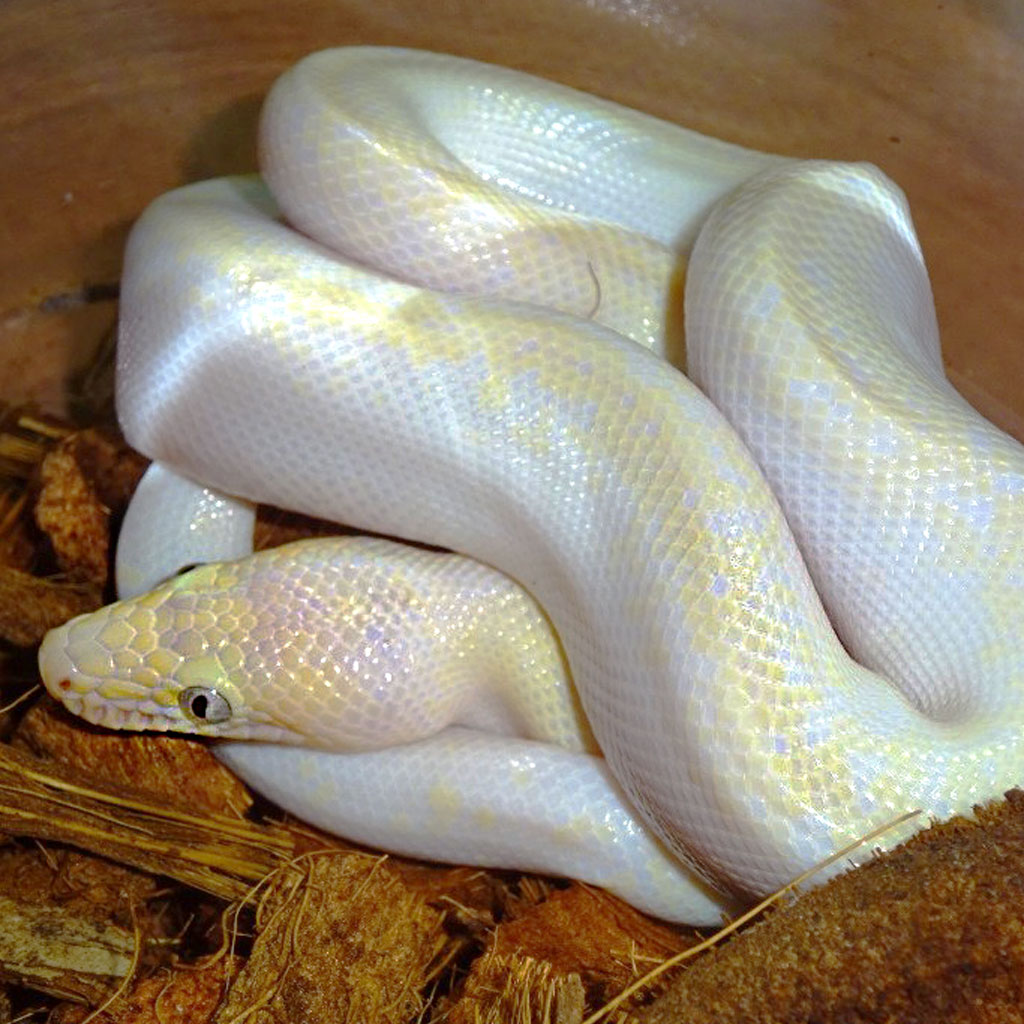
Your pet should be mature in weight and age before being considered for breeding to avoid any complications.
The recommendations for a female to breed are
• 3 to 4 years
• 5 feet length
• 1400 grams weight
Above mentioned criteria are minimum requirements.
Mating
Naturally, the mating season of rainbow boas is February till June, so this is the best time to introduce a female into a male’s vivarium for copulation. They should be left together for a few weeks. If this is successful females will get pregnant.
“Always introduce a female into a male’s vivarium to prevent aggressive behavior”.
Brumation
Hibernation typical of reptiles also occurs in rainbow boas. This subtype of hibernation is not true hibernation but a cold-blooded version of slowing down during low temperatures. This phenomenon occurs in the natural environment, however, if you maintain the temperature of a tank in the correct zone there is no need to worry about brumation.
However, brumation is not necessary for breeding whereas some breeders suggest that brumation before breeding shows beneficial results. If you decide to lower the temperature of your pet’s enclosure, drop it by a few degrees at night only and this should be done gradually and then maintain followed by gradually increasing it back to normal. This will replicate the cooling down phenomenon rainbow boas experience in their natural habitat, whereas humidity levels don’t vary greatly.
“The minimum requirement for a good brumation period is about 6 to 10 weeks”.
Gravidity
The female refuses to feed during gravidity; however, you should still offer her small feeds.
“Average gestation period is around 5 months”.
During gestation, the female becomes larger at the back end particularly.
Care should be taken not to disturb the female during labor, as this can cause stress to your pet and there is an increasing chance that your pet will end up having a stillborn.
Remove newly hatched boas as soon as they are born to prevent the mother from mistaking them for unfertilized slugs and eating them.
Handling Advice
In general, the rainbow boas don’t like to be handled, however, the behavior of your pet depends particularly on age.
After two years of age, they become calm and easy to handle. Older snakes will tolerate handling better than young ones.They should be handled as less as possible only to monitor the health of your pet. Rainbow boas are “NON-VENOMOUS”, however, young ones are likely to sting. For preventive purposes wear thick leather gloves, when your pet is young. Whereas, they have small, curved teeth with the ability to pierce gloves.
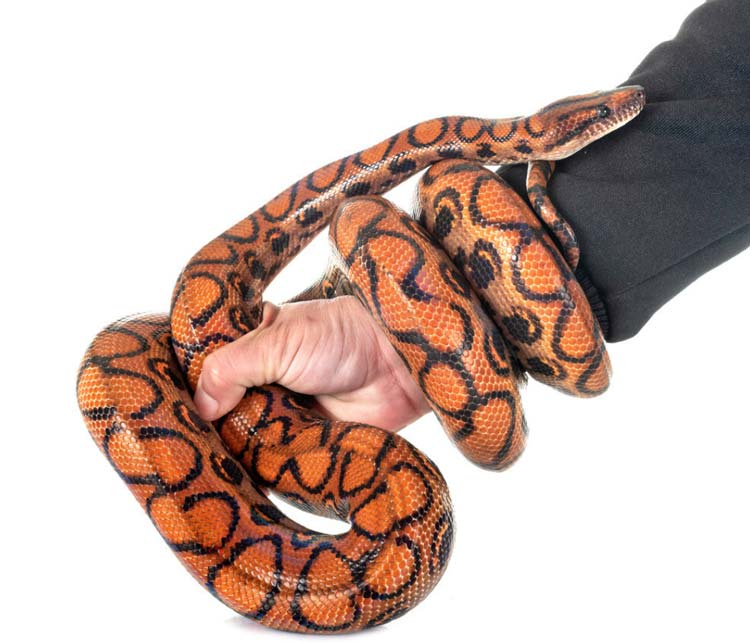
As they age, it is advised to stop wearing gloves to familiarize them with your scent and associate you with not being a threat to them.
During handling, the weight of your pet should be supported, never held directly behind their head to prevent stings or being bitten.
Nature; Aggressive or Friendly?
As they are well known to be “Reclusive in nature” preferably avoid interaction with one another or with other snake species.
In the natural habitat, the only time of interaction is the breeding season when the males compete with one another for females. They show their dominance while wrapping around one another and exerting pressure until one of them gives up.
“Challenging behavior and dominance are also shown by tongue flicking”.
When one of them surrenders, they put their head on the ground and leave. Otherwise, boas avoid interaction as well as communication with each other.
Similarly, they show their reclusive nature in the enclosure as well by mostly hiding in one of the hide boxes provided.
Costing
“In USA, the rainbow boas typically cost up to $200-$400 USD”.
Females are usually more on the expensive side, however, albinos and boas with albino genetics will cost up to $1000 USD.
Make sure your pet is healthy while purchasing, another point to keep in mind is that the rainbow boas reach their striking set of colors when they reach the age of two years.
Care Guide Summary
“Relatively easy requirements for care i.e, minimal lighting, some heating and misting as well as their diet is simple and minimal”
Makes them an easy pet.
However, while being young, they are not easy to handle and can bite, “they are not suited for beginners”.
This is one of the most beautiful specie of snake, eye-catching as well as challenging.








